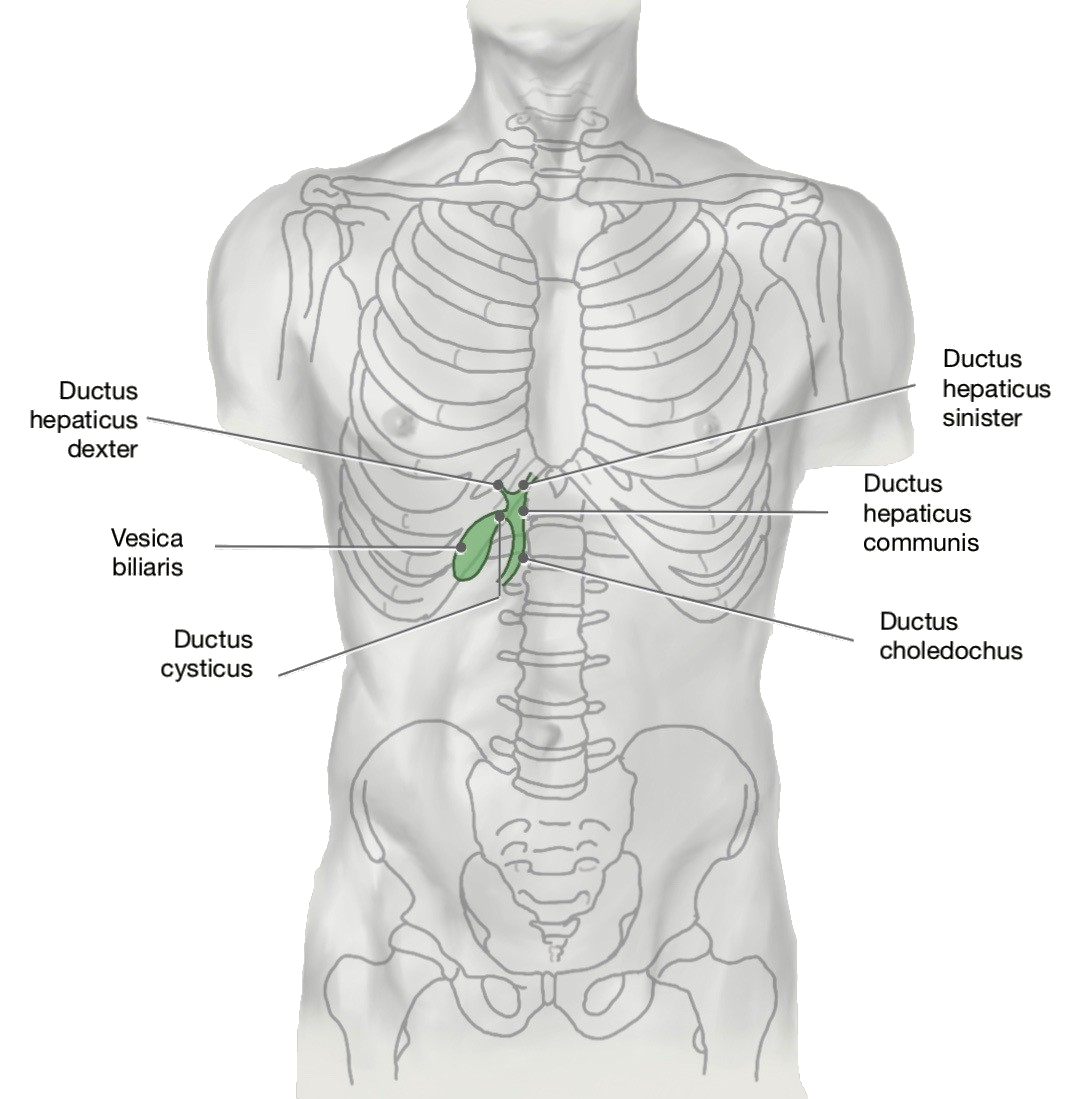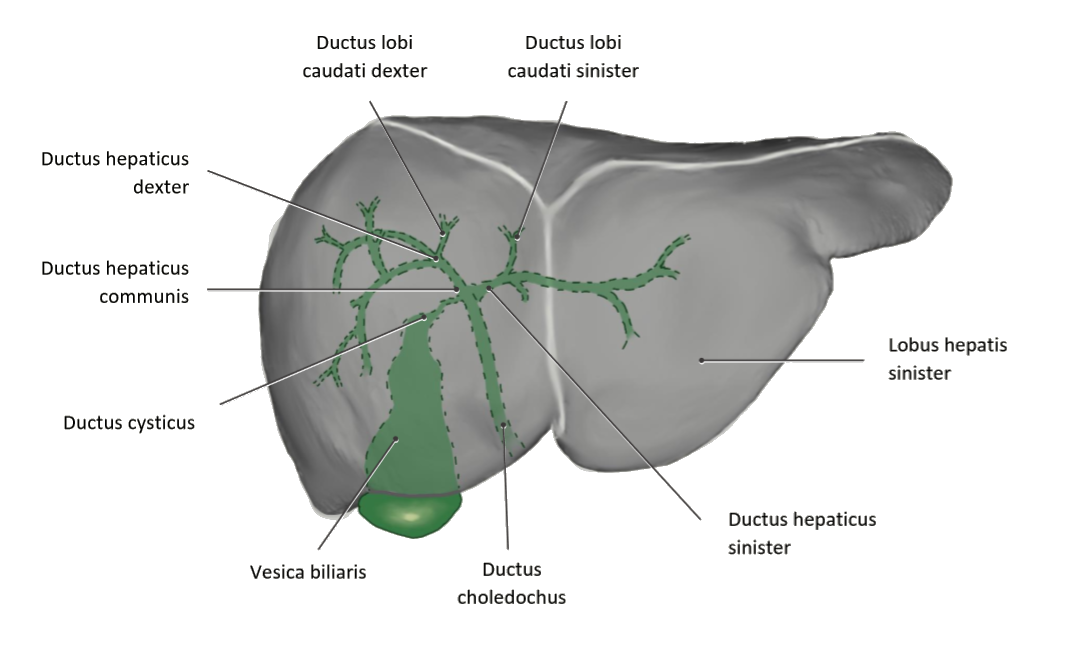Gallenblase (Vesica billiaris)/en: Unterschied zwischen den Versionen
(Übernehme Bearbeitung einer neuen Version der Quellseite) |
Becher (Diskussion | Beiträge) |
||
| (24 dazwischenliegende Versionen desselben Benutzers werden nicht angezeigt) | |||
| Zeile 1: | Zeile 1: | ||
| − | + | The gallbladder (lat. Vesica billiaris) is a hollow organ responsible for the thickening and storage of bile produced in the liver. This is needed during digestion. | |
<div class="button_style"> | <div class="button_style"> | ||
<div class ="center"> | <div class ="center"> | ||
<div class="dropdown"> | <div class="dropdown"> | ||
| − | <div class="floatright" style="margin:0.4em;">[[File:PfeilDropdown.png|20px|link=| | + | <div class="floatright" style="margin:0.4em;">[[File:PfeilDropdown.png|20px|link=|Exercises]]</div> |
| − | <div class="dropbtnart">[[Special:MyLanguage/Übungsaufgaben| | + | <div class="dropbtnart">[[Special:MyLanguage/Übungsaufgaben|Exercises]]</div> |
<div class="dropdown-content"> | <div class="dropdown-content"> | ||
| − | <div>[[Special:MyLanguage/Übungsaufgaben: Abdomen und Becken|Abdomen | + | <div>[[Special:MyLanguage/Übungsaufgaben: Abdomen und Becken|Abdomen and pelvis]]</div> |
| − | <div>[[Special:MyLanguage/Übungsaufgabe: Gallenblase| | + | <div>[[Special:MyLanguage/Übungsaufgabe: Gallenblase|Gallbladder]]</div> |
</div> | </div> | ||
</div> | </div> | ||
| Zeile 20: | Zeile 20: | ||
<div class="dropdown"> | <div class="dropdown"> | ||
| − | <div class="floatright" style="margin:0.4em;">[[File:PfeilDropdown.png|20px|link=| | + | <div class="floatright" style="margin:0.4em;">[[File:PfeilDropdown.png|20px|link=|Neighbouring structures]]</div> |
| − | <div class="dropbtnart"> | + | <div class="dropbtnart">Neighbouring structures</div> |
<div class="dropdown-content"> | <div class="dropdown-content"> | ||
| − | <div>[[Special:MyLanguage/Leber| | + | <div>[[Special:MyLanguage/Leber|Liver]]</div> |
| − | <div>[[Special:MyLanguage/Bauchspeicheldrüse| | + | <div>[[Special:MyLanguage/Bauchspeicheldrüse|Pancreas]]</div> |
| − | <div>[[Special:MyLanguage/Rippen| | + | <div>[[Special:MyLanguage/Rippen|Ribs]]</div> |
</div> | </div> | ||
</div> | </div> | ||
<div class="dropdown"> | <div class="dropdown"> | ||
| − | <div class="floatright" style="margin:0.4em;">[[File:PfeilDropdown.png|20px|link=| | + | <div class="floatright" style="margin:0.4em;">[[File:PfeilDropdown.png|20px|link=|Body regions]]</div> |
| − | <div class="dropbtnart">[[Special:MyLanguage/Körperregionen| | + | <div class="dropbtnart">[[Special:MyLanguage/Körperregionen|Body regions]]</div> |
<div class="dropdown-content"> | <div class="dropdown-content"> | ||
| − | <div>[[Special:MyLanguage/Organe Abdomen und Becken| | + | <div>[[Special:MyLanguage/Organe Abdomen und Becken|Organs of abdomen and pelvis]]</div> |
| − | <div>[[Special:MyLanguage/Innere Organe| | + | <div>[[Special:MyLanguage/Innere Organe|Inner organs]]</div> |
| − | <div>[[Special:MyLanguage/Rumpf| | + | <div>[[Special:MyLanguage/Rumpf|Trunk]]</div> |
</div> | </div> | ||
</div> | </div> | ||
<div class="dropdown"> | <div class="dropdown"> | ||
| − | <div class="floatright" style="margin:0.4em;">[[File:PfeilDropdown.png|20px|link=| | + | <div class="floatright" style="margin:0.4em;">[[File:PfeilDropdown.png|20px|link=|Organ system]]</div> |
| − | <div class="dropbtnart">[[Special:MyLanguage/Organsystem| | + | <div class="dropbtnart">[[Special:MyLanguage/Organsystem|Organ system]]</div> |
<div class="dropdown-content"> | <div class="dropdown-content"> | ||
| − | <div>[[Special:MyLanguage/Verdauungsapparat| | + | <div>[[Special:MyLanguage/Verdauungsapparat|Digestive system]]</div> |
</div> | </div> | ||
</div> | </div> | ||
---- | ---- | ||
| − | == | + | ==Projection of the gallbladder and extrahepatic bile ducts onto the trunk== |
<div class="thumb tright thumbinner"> | <div class="thumb tright thumbinner"> | ||
<div class="picture"> | <div class="picture"> | ||
| − | <lightbox-embedding src="file:gallenblaseLage.png" group="image-group-1" caption=" | + | <lightbox-embedding src="file:gallenblaseLage.png" group="image-group-1" caption="Gallbladder: projection of the gallbladder onto the trunk" width="400" height="300" style="width:300px; height:300px;float:left;margin:1px;background-color:#fff;border:1px solid #c8ccd1;display: flex;justify-content: center;"/> |
</div> | </div> | ||
<div class="thumbcaption" style="width:300px"> | <div class="thumbcaption" style="width:300px"> | ||
| − | + | Gallbladder: projection of the gallbladder onto the trunk</div> | |
</div> | </div> | ||
| − | + | The mouth of the ductus pancreaticus lies at the level of the 2nd lumbar vertebral body. In the right medioclavicular line, however, the gallbladder is visible at the lower edge of the 9th rib. Below the costal arch is the gallbladder at the level of the 1st or 2nd lumbar vertebra. | |
| − | == | + | ==Projection of intra- and extrahepatic bile ducts onto the surface of the liver== |
| − | === | + | ===Intrahepatic bile ducts=== |
<div class="thumb tright thumbinner"> | <div class="thumb tright thumbinner"> | ||
<div class="picture"> | <div class="picture"> | ||
| − | <lightbox-embedding src="file:Gallenwege.png" group="image-group-1" caption=" | + | <lightbox-embedding src="file:Gallenwege.png" group="image-group-1" caption="Gallbladder: bile ducts" width="400" height="300" style="width:300px; height:300px;float:left;margin:1px;background-color:#fff;border:1px solid #c8ccd1;display: flex;justify-content: center;"/> |
</div> | </div> | ||
<div class="thumbcaption" > | <div class="thumbcaption" > | ||
| − | + | Gallbladder: bile ducts</div> | |
</div> | </div> | ||
| − | + | All bile ducts up to the hepatic orifice (porta hepatis) are called intrahepatic bile ducts. | |
| − | + | Small bile ducts (canaliculi biliferi) are the bile ducts between the liver cells (hepatocyte). The bile ducts move from the center of a liver lobule to the lobule surface. Here they pass into the short herring ducts (ductuli biliferi). These again flow into the bile ducts inside the liver lobules (ductus biliferi interlobulares). They merge into ever larger units and eventually lead to the large intrahepatic liver ducts, the ductus hepaticus dexter and the ductus hepaticus sinister. | |
| − | === | + | ===Extrahepatic bile ducts=== |
| − | + | Extrahepatic bile ducts are those that are located outside the liver. | |
| − | + | The ductus hepaticus, which in most cases is outside the liver, proceeds from the left and right hepatic duct near the porta hepatis. The ductus cysticus is one way to store bile in the gall bladder. The ductus choledochus runs in the ligamentum hepatoduodenale to the duodenum. The last section of the ductus choledochus merges with the ductus pancreaticus of the pancreas to form the ampulla hepatopancreatica. This in turn flows through the papilla duodeni major into the duodenum. | |
| − | == | + | ==Position of the gall bladder in relation to the neighbouring organs== |
| − | + | In the <segmenter-snapshot wsemb_id="galle" snapshot_index="1" style="">"WebViewer"</segmenter-snapshot> stomach, small intestine, colon transversum, peritoneum in the area of lig. hepatoduodenale are removed and the liver is shown transparent. The gallbladder is firmly connected by the connective tissue of the fossa vesicae biliaris. The ductus choledochus runs behind the duodenum towards the pancreatic head and through it (not visible in <!--[segmenter_snapshot galle 0]-->"WebViewer"<!--[/]-->). Depending on this, the ductus choledochus either flows together or separately with the ductus pancreaticus on the papilla duodeni major in the pars descendens duodeni. | |
<div class="clear"></div> | <div class="clear"></div> | ||
| − | == | + | ==Structure of the gall bladder and extrahepatic bile ducts== |
| − | + | The gallbladder consists of a neck (collum), a body (corpus) and a bladder base (fundus). The corpus vesicae biliaris enters the neck via the gallbladder funnel. The ducuts cysticus (gallbladder duct) attaches to the neck, which leads to the ductus hepaticus communis. The large bile duct is called ductus choledochus. There the ductus pancreaticus flows, both ducts lead their digestive secretions via the papila duodeni major into the duodenum. </br> | |
| − | + | There are further variants of the mouths of ductus choledochus and ductus pancreaticus. Gallbladder and ductus cysticus are more rarely doubled. Another variant is an almost completely seperated common ampoule. Also possible is an orifice without a real ampoule and a double orifice of both veins. | |
| − | <br><br> | + | </br></br> |
| − | == | + | ==Diseases== |
| − | *[[Special:MyLanguage/Gallensteine| | + | *[[Special:MyLanguage/Gallensteine|Gallstones]] |
*[[Special:MyLanguage/Cholezystitis|Cholezystitis]] | *[[Special:MyLanguage/Cholezystitis|Cholezystitis]] | ||
| − | == | + | ==Free exploration== |
<div style="float:left;margin-right:1em;"><segmenter-embedding wsemb_id="galle" src="segmenter:W9gqCz57DczV" height="300px" width="500px"/></div> | <div style="float:left;margin-right:1em;"><segmenter-embedding wsemb_id="galle" src="segmenter:W9gqCz57DczV" height="300px" width="500px"/></div> | ||
| − | <div style="float:left;width:50%"> | + | <div style="float:left;width:50%">Look at the structure of the gallbladder in 3D and explore it freely. Afterwards you can test your acquired knowledge by the exercises.</div> |
<div class="clear"></div> | <div class="clear"></div> | ||
| Zeile 112: | Zeile 112: | ||
<div class="clear aufgaben"> | <div class="clear aufgaben"> | ||
<div class="menu_item"> | <div class="menu_item"> | ||
| − | <li class="button_article"><b> | + | <li class="button_article"><b>Further article</b></li> |
</div> | </div> | ||
<div class="menu_item"> | <div class="menu_item"> | ||
| − | <li class="mw-ui-button button_normal">[[Special:MyLanguage/Magen| | + | <li class="mw-ui-button button_normal">[[Special:MyLanguage/Magen|Stomach]]</li> |
</div> | </div> | ||
<div class="menu_item"> | <div class="menu_item"> | ||
| − | <li class="mw-ui-button button_normal">[[Special:MyLanguage/Humerus| | + | <li class="mw-ui-button button_normal">[[Special:MyLanguage/Humerus|Humerus]]</li> |
</div> | </div> | ||
</div> | </div> | ||
| Zeile 126: | Zeile 126: | ||
---- | ---- | ||
| − | [[Category: | + | [[Category:Organs abdomen]] |
| − | [[Category: | + | [[Category:Inner organs]] |
| − | [[Category: | + | [[Category:Organ system]] |
| − | [[Category: | + | [[Category:Body regions]] |
</div> | </div> | ||
<languages/> | <languages/> | ||
Aktuelle Version vom 18. Dezember 2020, 11:09 Uhr
The gallbladder (lat. Vesica billiaris) is a hollow organ responsible for the thickening and storage of bile produced in the liver. This is needed during digestion.
Inhaltsverzeichnis
- 1 Projection of the gallbladder and extrahepatic bile ducts onto the trunk
- 2 Projection of intra- and extrahepatic bile ducts onto the surface of the liver
- 3 Position of the gall bladder in relation to the neighbouring organs
- 4 Structure of the gall bladder and extrahepatic bile ducts
- 5 Diseases
- 6 Free exploration
Projection of the gallbladder and extrahepatic bile ducts onto the trunk
The mouth of the ductus pancreaticus lies at the level of the 2nd lumbar vertebral body. In the right medioclavicular line, however, the gallbladder is visible at the lower edge of the 9th rib. Below the costal arch is the gallbladder at the level of the 1st or 2nd lumbar vertebra.
Projection of intra- and extrahepatic bile ducts onto the surface of the liver
Intrahepatic bile ducts
All bile ducts up to the hepatic orifice (porta hepatis) are called intrahepatic bile ducts. Small bile ducts (canaliculi biliferi) are the bile ducts between the liver cells (hepatocyte). The bile ducts move from the center of a liver lobule to the lobule surface. Here they pass into the short herring ducts (ductuli biliferi). These again flow into the bile ducts inside the liver lobules (ductus biliferi interlobulares). They merge into ever larger units and eventually lead to the large intrahepatic liver ducts, the ductus hepaticus dexter and the ductus hepaticus sinister.
Extrahepatic bile ducts
Extrahepatic bile ducts are those that are located outside the liver. The ductus hepaticus, which in most cases is outside the liver, proceeds from the left and right hepatic duct near the porta hepatis. The ductus cysticus is one way to store bile in the gall bladder. The ductus choledochus runs in the ligamentum hepatoduodenale to the duodenum. The last section of the ductus choledochus merges with the ductus pancreaticus of the pancreas to form the ampulla hepatopancreatica. This in turn flows through the papilla duodeni major into the duodenum.
Position of the gall bladder in relation to the neighbouring organs
In the "WebViewer" stomach, small intestine, colon transversum, peritoneum in the area of lig. hepatoduodenale are removed and the liver is shown transparent. The gallbladder is firmly connected by the connective tissue of the fossa vesicae biliaris. The ductus choledochus runs behind the duodenum towards the pancreatic head and through it (not visible in "WebViewer"). Depending on this, the ductus choledochus either flows together or separately with the ductus pancreaticus on the papilla duodeni major in the pars descendens duodeni.
Structure of the gall bladder and extrahepatic bile ducts
The gallbladder consists of a neck (collum), a body (corpus) and a bladder base (fundus). The corpus vesicae biliaris enters the neck via the gallbladder funnel. The ducuts cysticus (gallbladder duct) attaches to the neck, which leads to the ductus hepaticus communis. The large bile duct is called ductus choledochus. There the ductus pancreaticus flows, both ducts lead their digestive secretions via the papila duodeni major into the duodenum.
There are further variants of the mouths of ductus choledochus and ductus pancreaticus. Gallbladder and ductus cysticus are more rarely doubled. Another variant is an almost completely seperated common ampoule. Also possible is an orifice without a real ampoule and a double orifice of both veins.
Diseases
Free exploration

